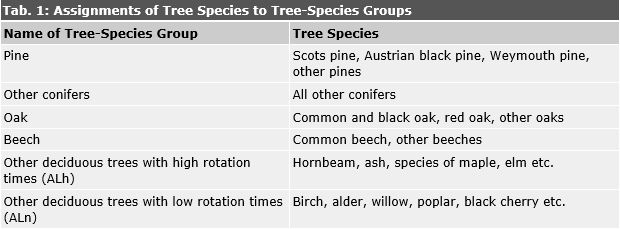An important structural instrument for forest assessment data is the structure of forest lands in layers. Certainly, the progressing development of an age-mixed near-natural forest makes adherence to the mapping methods of inventory layers developed under forestry-management aspects increasingly difficult, since the clearly recognizable stratification is broken down – as is the intention. Still, the yet-prevailing inventory conditions at present make a layer-based description of the forest appropriate.
The five inventory layers certified for the Berlin forests are explained more precisely below, since e.g. the distribution of tree species among the various layers can lead to important conclusions for the further development of the inventory.
In the age-class forest, that layer of the forest is considered the Main Stock which is the most important and most characteristic for the stock from a forestry-management point of view. All forestry measures are concentrated on the main stock, until the target strength is achieved. The age of the main stock can vary strongly. After the reforestation of a clear cut, the one-year-old plants already constitute the main stock, while old, self-contained stocks may be 140 years old, or older. The tree species dominating the respective layer is the main tree species; other species of trees are described as mixed-tree species.
Reserve Trees are usually individual trees which are of greater age than the main tree layer. There is no clear line separating this category from that of Residual Stocks; ultimately, the number of still existing trees is the determining factor. Trees in these two layers are the points of departure for the natural rejuvenation of the forest.
The layer of the trees which are young and not yet stock-forming is described as Undergrowth or Secondary Growth. The assignment to undergrowth or to secondary growth, respectively, is carried out on the one hand on the basis of tree species (over the long run, secondary growth is to constitute the main stock, therefore undesirable species such as the black cherry cannot be classed as secondary growth); and on the other on the basis of the vitality and quality of the trees (misshapen, weak trees and those of undesirable species are classed as undergrowth). In a near-natural forest, undergrowth and secondary growth occur as natural rejuvenation (e.g. by natural seeding from reserve trees).
A comparison of tree species composition of the main stock with that of the undergrowth and secondary growth shows a clear shift from pine to deciduous trees. This is an important indicator that the Berlin forests are on the right path in management with the goal of moving the Berlin forest in a more near-natural direction (see graphics in the chapter Data Evaluations).
Unlike the 1995 Environmental Atlas, the separate representation of florally exotic species of trees has not been undertaken in the present version. These tree species are still recorded in detail through the forestry assessment, and can also be evaluated. However, the experiences collected over the past decades indicates that maximum success in the fight against such neophytes is not necessarily assured by maximum expense. The natural aging and dying of undesirable tree species due to competition with desired tree species may in many cases lead to the goal just as surely, and much more economically. A separate representation therefore seems no longer required. The present forest assessment data stock is based on the following assignments tree species to tree-species groups:

